Scandinavian Erratics in the Cultural Heritage Sites of Western Poland
Abstract
1. Introduction
2. Objectives and Research Methods
3. Study Area
4. Overview of Historical Objects
4.1. Church of St. Elizabeth of Hungary in Dolsk (Myślibórz Lake District); No. 1 in Figure 1
4.2. Church of the Holy Spirit in Moryń (Myślibórz Lake District); No. 2 in Figure 1
4.3. Paved Salt Trail in Ostrowiec (Drawieński National Park); No. 3 in Figure 1
4.4. Megalithic Tomb of the Globular Amphora Culture in Kierzkowo, Pałuki; No. 4 in Figure 1
4.5. The Benedictine Abbey in Lubin (South Wielkopolskie [Greater Poland] Lake District); No. 5 in Figure 1
5. Discussion
6. Conclusions
- The historic use of erratic boulders is a topic worthy of further investigation. The use of Scandinavian erratic boulders in north-western Poland as building materials for both sacred and secular structures has been documented since ancient times. Such boulders are found in a variety of structures, including megalithic tombs, Pomeranian churches, town walls, paved roads and cathedrals.
- In cultural heritage sites, these boulders are employed primarily for structural purposes, but they also serve to represent regional traditions, culture and identity. The utilisation of these boulders in historical edifices serves to bridge the fields of geology and cultural heritage.
- The presence of erratic boulders provides a range of geosystem services, including educational, pro-environmental, geoethical, and aesthetic benefits. Such boulders contribute to sustainable regional development and the promotion of geotourism, which in turn enhances the conservation of the geological environment.
- The most commonly used rock type, irrespective of the studied cultural heritage site of western Poland, was granite. Its proportion averaged 50–60% of all analysed rocks. Durability, resistance to deterioration and relatively easy stoneworking are all features that have been noticed in this petrographic type. Stonemasons also frequently used gneisses (approximately 15%) and less commonly sandstones and quartzites. Among the indicator erratics, Småland granites from south-eastern Sweden and rapakivi granites from the Åland Islands were most frequently identified. Additionally, single specimens of such erratics from Dalarna (central Sweden), Blekinge (southeastern Skåne), and other locations were also identified.
- The Megalithic Tomb at Kierzkowo is a significant archaeological site. This prehistoric tomb, constructed with glacial erratics, exemplifies granite as the dominant rock type. The boulders were selected for their durability and aesthetic value, reflecting both functional and symbolic considerations.
- The Church of the Holy Spirit in Moryń is a notable example of Gothic architecture. The church was constructed in the 13th century and features a high percentage of granites and gneisses among the 2147 boulders that were analysed. The checkerboard motif, for instance, serves to highlight the cultural significance of these rocks.
- The paved road in Ostrowiec is notable for its use of granite and gneiss. Constructed in the nineteenth century, this road is predominantly composed of granites, with sandstones and gneisses also present. The boulders, which have been identified as indicator erratics, serve to illustrate the geoheritage of the region.
- The Benedictine Abbey in Lubin is a notable example of the region’s geoheritage. The construction phases of the abbey demonstrate a consistent use of granites, gneisses and quartzites. The presence of indicator erratics from Scandinavia serves to illustrate the geological diversity and historical significance of the building materials.
Author Contributions
Funding
Data Availability Statement
Acknowledgments
Conflicts of Interest
References
- Meyer, K.-D.; Lüttig, G. Was meinen wir mit Leitgeschiebe? Geschiebekd. Aktuell 2007, 23, 106–121. [Google Scholar]
- Górska-Zabielska, M. The most valuable erratic boulders in the Wielkopolska region of western Poland and their potential to promote geotourism. GeoJournal Tour. Geosites 2020, 29, 694–714. [Google Scholar] [CrossRef]
- Lüttig, G. Methodische Fragen der Geschiebeforschung. Geol. Jahrb. 1958, 75, 361–418. [Google Scholar]
- Czubla, P.; Gałązka, D.; Górska, M. Eratyki przewodnie w glinach morenowych Polski. Przegląd Geol. 2006, 54, 352–362. [Google Scholar]
- Górska-Zabielska, M. Fennoskandzkie Obszary Alimentacyjne Osadów Akumulacji Glacjalnej i Glacjofluwialnej Lobu Odry; Wydawnictwo Naukowe Uniwersytetu im. Adama Mickiewicza w Poznaniu: Poznań, Poland, 2008; Volume 78, p. 330. [Google Scholar]
- Świechowski, Z. Architektura Granitowa Pomorza Zachodniego w XIII Wieku; Poznańskie Towarzystwo Przyjaciół Nauk, Prace Komisji Historii Sztuki: Poznań, Poland, 1950; Volume 2. [Google Scholar]
- Świechowski, Z. Architektura Romańska w Polsce; Wyd. DiG: Warszawa, Poland, 2000; p. 674. [Google Scholar]
- Prinke, A.; Skoczylas, J. Z metodyki badań nad użytkowaniem surowców kamiennych w neolicie. Przegląd Archeol. 1978, 26, 43–66. [Google Scholar]
- Haiduck, H. Die Architektur der Mittelalterlichen Kirchen im Ostfriesischen Küstenraum; Verlag Ostfriesische Landschaft Aurich: Aurich, Germany, 1986. [Google Scholar]
- Pfeifer, V. Feldsteinkirchen im Flämming. In Ein Kunsthistorischer und Touristischer Führer; Viola Pfeifer Verlag: Berlin, Germany, 1997. [Google Scholar]
- Skibiński, S. Technika “grubego muru” w średniowiecznej architekturze Pomorza Zachodniego. In Ars sine Scientia Nihil Est, Księga Ofiarowana Profesorowi Zygmuntowi Świechowskiemu; Olenderek, J., Ed.; Dom Wydawniczy ARS, Fundacja Kultury Polskiej, Instytut Architektury i Urbanistyki Wydziału Budownictwa i Architektury Politechniki Łódzkiej: Warszawa, Poland, 1997; pp. 235–239. [Google Scholar]
- Ibbeken, H. Die Mittelalterlichen Feld- und Bruchsteinkirchen des Flämming; Berliner Wissenschafts-Verlag: Berlin, Germany, 1999. [Google Scholar]
- Jarzewicz, J. Gotycka Architektura Nowej Marchii. Budownictwo Sakralne w Okresie Askańczyków i Wittelsbachów; Poznańskie Towarzystwo Przyjaciół Nauk, Prace Komisji Historii Sztuki: Poznań, Poland, 2000; Volume 29. [Google Scholar]
- Stilling, N.P. Danmarks Kiker; Politikens: Kopenhagen, Denmark, 2000. [Google Scholar]
- Badstübner, E.; Böttcher, U. Feldsteinkirchen des Mittelalters in Brandenburg und in Mecklenburg-Vorpommern; Hinstorff: Rostock, Germany, 2002. [Google Scholar]
- Bungenstock, F.; Meyer, K.-D. Zeugen der Eiszeit in den Wänden der Kirche von Marx; Niedersächsisches Institut für Historische Küstenforschung: Wilhelmshaven, Germany, 2003. [Google Scholar]
- Król, D.; Woźniak, P.P.; Zakrzewski, L. Kamienie Szwedzkie w Kulturze i Sztuce Pomorza; Muzeum Archeologiczne w Gdańsku: Gdańsk, Poland, 2004. [Google Scholar]
- Riepshoff, H.; Bungenstock, F. Wie die Mauern der Bockhorner Kirche die Geschichte der Eiszeiten erzählen; Niedersächsisches Institut für Historische Küstenforschung: Wilhelmshaven, Germany, 2005. [Google Scholar]
- Kunkel, R. Architektura Gotycka na Mazowszu; Wyd. DiG: Warszawa, Poland, 2006. [Google Scholar]
- Meyer, K.-D. Findlingskirchen in Norddeutschland. In Denkmalgesteine—Festschrift—Wolf-Dieter Grimm; Siegesmund, S., Snethlage, R., Eds.; Schriftenreihe der Deutschen Gesellschaft fuer Geowissenschaften: Hannover, Germany, 2008; Volume 59, pp. 128–138. [Google Scholar]
- Meyer, K.-D. Taufsteine in Norddeutschland. Material, Herkunft und Alter. In Abhandlungen und Berichte für Naturkunde; Verlag Museum für Naturkunde: Magdeburg, Germany, 2011; Volume 33, pp. 5–106. [Google Scholar]
- Nowaczyk, S.z.; Pospieszny, Ł.; Sobkowiak-Tabaka, I. (Eds.) Megalityczny grobowiec kultury amfor kulistych z Kierzkowa. Milczący świadek kultu przodków z epoki kamienia. In Biskupińskie Prace Archeologiczne; Muzeum Archeologiczne w w Biskupinie: Biskupin, Poland, 2017; Volume 12. [Google Scholar]
- Górska-Zabielska, M.; Dobracki, R. Petrographic Garden in Moryń—A new geotouristic attraction in western Poland. Landf. Anal. 2015, 29, 73–80. [Google Scholar] [CrossRef]
- Jóźwiak, K.; Stępień, M. Petrografia okolic Drawnika. In Geościeżka w Dolinie Drawy; Bąkowska, A., Ed.; Wyd. Drawa National Park: Drawno, Poland, 2013; pp. 50–78. [Google Scholar]
- Górska-Zabielska, M. Some geotouristic values of the Drawno National Park—A Project of petrographic route. In Ekomuzeum Rzeki Drawy; Januszewski, S., Ed.; Wyd. Drawno National Park, Foundation of the Open Museum of Technology: Drawno, Poland, 2010; pp. 107–116. [Google Scholar]
- Skoczylas, J. Użytkowanie Surowców Skalnych We Wczesnym Średniowieczu w Północno-Zachodniej Polsce; Wydawnictwo Naukowe Uniwersytetu im. Adama Mickiewicza w Poznaniu: Poznań, Poland, 1990. [Google Scholar]
- Skoczylas, J. Zróżnicowanie użytkowania czwartorzędowych surowców skalnych w Wielkopolsce w neolicie i we wczesnym średniowieczu. In Funkcjonowanie Geoekosystemów w Zróżnicowanych Warunkach Morfoklimatycznych—Monitoring, Ochrona, Edukacja; Karczewski, A., Zwoliński, Z., Eds.; Bogucki Wydawnictwo Naukowe: Poznań, Poland, 2001; pp. 491–501. [Google Scholar]
- Skoczylas, J. Kamień w Państwie Pierwszych Piastów; Opuscula Gnesnensia: Gniezno, Poland, 2016; Volume 12. [Google Scholar]
- Skoczylas, J.; Walendowski, H. Kamień w Zabytkowej Architekturze Ostrowa Tumskiego w Poznaniu. Przegląd Geol. 1998, 46, 1146–1152. [Google Scholar]
- Skoczylas, J. Wykorzystanie Surowców Skalnych w Średniowiecznej Architekturze Lubinia Koło Gostynia. Geologos 1996, 1, 203–213. [Google Scholar]
- Migoń, P. Geoturystyka; Wydawnictwo Naukowe PWN: Warszawa, Poland, 2012. [Google Scholar]
- von Rohrscheidt, A.M. Potencjał turystyki kulturowo-przyrodniczej w Polsce. Gnieźnieńskie Forum Ekspertów Turystyki Kulturowej, Pytanie 65. Tur. Kult. 2016, 1, 203–218. [Google Scholar]
- Reynard, E.; Giusti, C. The landscape and the cultural value of geoheritage. In Geoheritage. Assessment, Protection, and Management; Reynard, E., Brilha, J., Eds.; Elsevier: Amsterdam, The Netherlands, 2018; pp. 147–166. [Google Scholar]
- Olson, K.; Dowling, R. Geotourism and cultural heritage. Geoconserv. Res. 2018, 1, 37–41. [Google Scholar]
- Kubalíková, L.; Kirchner, K.; Kuda, F.; Bajer, A. Assessment of urban geotourism resources: An example of two geocultural sites in Brno, Czech Republic. Geoheritage 2020, 12, 7. [Google Scholar] [CrossRef]
- Pijet-Migoń, E.; Migoń, P. Geoheritage and Cultural Heritage—A Review of Recurrent and Interlinked Themes. Geosciences 2022, 12, 98. [Google Scholar] [CrossRef]
- Skoczylas, J.; Skoczylas, Ł. Kamienne bruki Starego Rynku w Poznaniu jako element dziedzictwa kulturowego. Przegląd Geol. 2020, 68, 535–539. [Google Scholar] [CrossRef]
- Skoczylas, J.; Skoczylas, Ł. Kamienne bruki Górnego Miasta w Poznaniu. Przegląd Geol. 2020, 68, 774–779. [Google Scholar] [CrossRef]
- Zgłobicki, W.; Warowna, J.; Baran-Zgłobicka, B.; Gajek, G.; Jezierski, W. Turystyka kulturowa a geoturystyka. Walory turystyczne geostanowisk kulturowych w Polsce. Tur. Kult. 2015, 6, 51–67. [Google Scholar]
- Central Register of Geosites of Poland. Available online: https://geologia.pgi.gov.pl/geostanowiska/ (accessed on 25 July 2024).
- Górska-Zabielska, M.; Zabielski, R. Geotourism Development in an Urban Area based on the Local Geological Heritage (Pruszków, Central Mazovia, Poland). In Urban Geomorphology. Landforms and Processes in Cities; Thornbush, M.J., Allen, C.D., Eds.; Elsevier: Amsterdam, The Netherlands, 2008; pp. 37–54. [Google Scholar] [CrossRef]
- Górska-Zabielska, M.; Zabielski, R. Stone in an urban space—Its potential to promote geotourism. GeoJournal Tour. Geosites 2019, 26, 1033–1045. [Google Scholar] [CrossRef]
- Wolniewicz, P. Bringing the History of the Earth to the Public by Using Storytelling and Fossils from Decorative Stones of the City of Poznań, Poland. Geoheritage 2019, 11, 1827–1837. [Google Scholar] [CrossRef]
- Wolniewicz, P. Where Geoheritage Meets Cultural Heritage: Historical Stone Use in the City of Poznań, Poland, and Its Economic and Political Background. Geoheritage 2024, 16, 11. [Google Scholar] [CrossRef]
- Kieliszek, Z.; Kulczyk, S. Przewodnicy sudeccy jako moderatorzy dostawy kulturowych usług ekosystemowych w Karkonoskim Parku Narodowym. Pr. I Stud. Geogr. 2024, 69, 111–123. [Google Scholar] [CrossRef]
- Marks, L.; Dzierżek, J.; Janiszewski, R.; Kaczorowski, J.; Lindner, L.; Majecka, A.; Makos, M.; Szymanek, M.; Tołoczko-Pasek, A.; Woronko, B. Quaternary stratigraphy and palaeogeography of Poland. Acta Geol. Pol. 2000, 66, 403–427. [Google Scholar] [CrossRef]
- Wysota, W.; Molewski, P. Chronologia i zasięgi nasunięć lądolodu na obszarze lobu Wisły podczas stadiału głównego ostatniego zlodowacenia. Przegląd Geol. 2011, 59, 214–225. [Google Scholar]
- Marks, L. Timing of the Late Vistulian (Weichselian) glacial phases in Poland. Quat. Sci. Rev. 2012, 44, 81–88. [Google Scholar] [CrossRef]
- Marks, L.; Bińka, K.; Woronko, B.; Majecka, A.; Teodorski, A. Revision of the late Middle Pleistocene stratigraphy and palaeoclimate in Poland. Quat. Int. 2019, 534, 5–17. [Google Scholar] [CrossRef]
- Costanza, R.; d’Arge, R.; de Groot, R.; Farberk, S.; Grasso, M.; Hannon, B.; Limburg, K.; Naeem, S.; O’Neill, R.V.; Paruelo, J.; et al. The value of the world’s ecosystem services and natural capital. Nature 1997, 387, 253–260. [Google Scholar] [CrossRef]
- Chen, H.; Sloggy, M.R.; Dhiaulhaq, A.; Escobedo, F.J.; Rasheed, A.R.; Sánchez, J.J.; Yang, W.; Yu, F.; Meng, Z. Boundary of ecosystem services: Guiding future development and application of the ecosystem service concepts. J. Environ. Manag. 2023, 344, 118752. [Google Scholar] [CrossRef]
- Gray, M.; Fox, N.; Gordon, J.E.; Brilha, J.; Charkraborty, A.; Garcia, M.d.G.; Hjort, J.; Kubalíková, L.; Seijmonsbergen, A.C.; Urban, J. Boundary of ecosystem services: A response to. J. Environ. Manag. 2024, 351, 119666. [Google Scholar] [CrossRef]
- Gray, M. Geodiversity: Valuing and Conserving Abiotic Nature, 2nd ed.; Wiley Blackwell: Chichester, UK, 2013. [Google Scholar]
- Van Ree, C.C.D.F.; Van Beukering, P.J.H. Geosystem services: A concept in support of sustainable development of the subsurface. Ecosyst. Serv. 2016, 20, 30–36. [Google Scholar] [CrossRef]
- Górska-Zabielska, M. New Geoeducational Facilities in Central Mazovia (Poland) Disseminate Knowledge about Local Geoheritage. Sustainability 2023, 15, 16115. [Google Scholar] [CrossRef]
- Górska-Zabielska, M.; Witkowska, K.; Pisarska, M.; Musiał, R.; Jońca, B. The Selected Erratic Boulders in the Świętokrzyskie Province (Central Poland) and Their Potential to Promote Geotourism. Geoheritage 2020, 12, 1–14. [Google Scholar] [CrossRef]
- Dowling, R.K. Geotourism’s Global Growth. Geoheritage 2010, 3, 1–13. [Google Scholar] [CrossRef]
- Elmi, C.; Simal, A.G.; Winchester, G.P. Developing a Rock Garden at Edith J. Carrier Arboretum, Harrisonburg VA (U.S.A.) as a Resource for Promoting Geotourism. Geosciences 2020, 10, 415. [Google Scholar] [CrossRef]
- Frey, M.-L. Geotourism—Examining Tools for Sustainable Development. Geosciences 2021, 11, 30. [Google Scholar] [CrossRef]
- Doswell, R. Chapter 3—The Tourism Product; Tourism; Doswell, R., Ed.; Butterworth-Heinemann: Oxford, UK, 1997; pp. 47–66. [Google Scholar] [CrossRef]
- Koutoulas, D. Understanding the Tourism Product. In Interim Symposium of the Research Committee on International Tourism of the International Sociological Association (ISA) on the Topic: “Understanding Tourism—Theoretical Advances” 14–16 May 2004; University of the Aegean: Mytilini, Greece, 2004; Available online: https://www.researchgate.net/publication/280317594_Understanding_the_Tourism_Product (accessed on 23 July 2024).
- Miśkiewicz, K. Geotourism product as a geoeducational tool and a method of promoting geological heritage of Poland. Przegląd Geol. 2023, 71, 314–320. [Google Scholar]
- Peppoloni, S.; Di Capua, G. Geoethics and geological culture: Awareness, responsibility and challenges. Ann. Geophys. 2012, 55, 335–341. [Google Scholar]
- Peppoloni, S.; Di Capua, G. Geoethics: Ethical, social, and cultural values in geosciences research, practice, and education. In Geoscience for the Public Good and Global Development: Toward a Sustainable Future; Wessel, G., Greenberg, J., Eds.; Geological Society of America: Boulder, CO, USA, 2016; Special Paper 520; pp. 17–21. [Google Scholar]
- Mansur, K.L.; Ponciano, L.C.M.O.; De Castro, A.R.S.F. Contributions to a Brazilian Code of Conduct for Fieldwork in Geology: An approach based on Geoconservation and Geoethics. An. Acad. Bras. Ciênc. 2017, 89 (Suppl. S1), 431–444. [Google Scholar] [CrossRef]
- Vasconcelos, C.; Schneider-Voß, S.; Peppoloni, S. (Eds.) Teaching Geoethics: Resources for Higher Education; U. Porto Edigdes: Porto, Portugal, 2021. [Google Scholar] [CrossRef]
- Koupatsiaris, A.A.; Drinia, H. Expanding Geoethics: Interrelations with Geoenvironmental Education and Sense of Place. Sustainability 2024, 16, 1819. [Google Scholar] [CrossRef]
- Skoczylas, J.; Zielinski, P. Znaki kamieniarskie a początki średniowiecznego kamieniarstwa. Świat Kamienia 2006, 6, 138–141. [Google Scholar]
- Smoleński, M. Modelowanie przestrzeni turystycznej peryferyjnych regionów turystycznych. Econ. Manag. 2012, 1, 64–91. [Google Scholar]
- Górska-Zabielska, M. Obszary macierzyste skandynawskich eratyków przewodnich osadów ostatniego zlodowacenia północno-zachodniej Polski i północno-wschodnich Niemiec. Geologos 2008, 14, 177–194. [Google Scholar]
- Korn, J. Die Wichtigste Leitgeschiebe der Nordischen Kristallinen Gesteine im Norddeutschen Flachlande; Preuß. Geol. Landesanstalt: Berlin, Germany, 1927; p. 64. [Google Scholar]
- Hesemann, J. Kristalline Geschiebe der Nordischen Vereisungen; Geologisches Landesamt Nordrhein-Westphalen: Krefeld, Germany, 1975; p. 267. [Google Scholar]
- Zandstra, J.G. Platenatlas van Noordelijke Kristalijne Gidsgesteenten; Backhuys Publishers: Leiden, The Netherlands, 1999; p. 412. [Google Scholar]
- Smed, P.; Ehlers, J. Steine aus dem Norden. Geschiebe als Zeugen der Eiszeit in Norddeutschland; Gebrüder Borntraeger: Berlin, Stuttgart, Germany, 2002; p. 194. [Google Scholar]
- Schulz, W. Sedimentäre Findlinge im norddeutschen Vereisungsgebiet. Arch. F. Geschiebekd. 1999, 2, 523–560. [Google Scholar]
- Schulz, W. Geologischer Führer für den Norddeutschen Geschiebesammler; CW Verlagsgruppe Schwerin: Schwerin, Germany, 2003; p. 508. [Google Scholar]
- Rudolph, F. Strandsteine: Sammeln & Bestimmen von Steinen an der Ostseeküste; Wachholtz Verlag Neumünster: Neumünster, Germany, 2005; p. 160. [Google Scholar]
- Svenson, C. Geschützte Findlinge der Insel Rügen; Landesamt für Umwelt, Naturschutz und Geologie Mecklenburg-Vorpommern: Güstrow, Germany, 2005; p. 28. [Google Scholar]
- Available online: https://eturystyka.wzp.pl/en/Plan_your_trip-Practical_information-Miejsca_kultu_religijnego-Kosciol_Rzymskokatolicki/a,1238/The_St_Elisabeth_of_Hungary_branch_church (accessed on 16 July 2024).
- Available online: https://zabytek.pl/pl/obiekty/g-220871 (accessed on 16 July 2024).
- Available online: https://zabytek.pl/en/obiekty/moryn-kosciol-parafialny-pw-swietego-ducha (accessed on 16 July 2024).
- Available online: https://medievalheritage.eu/en/main-page/heritage/poland/moryn-holy-spirit-church/ (accessed on 16 July 2024).
- Available online: http://geostanowiska.pgi.gov.pl/gsapp_v2/ObjectDetails.aspx?id=90 (accessed on 16 July 2024).
- Górska-Zabielska, M. O niektórych zasobach geoturystycznych planowanego geoparku “Kraina polodowcowa nad Odrą”. In Uwarunkowania i Plany Rozwoju Turystyki. Turystyka Przyrodnicza i Uwarunkowania jej Rozwoju; Młynarczyk, Z., Zajadacz, A., Eds.; Turystyka i Rekreacja—Studia i Prace; Bogucki Wydawnictwo Naukowe: Poznań, Poland, 2016; Volume 18, pp. 9–26. [Google Scholar]
- Available online: https://www.nadrawie.pl/turystyka.htm (accessed on 16 July 2024).
- Górska-Zabielska, M. Analiza petrograficzna głazów narzutowych w grobowcu megalitycznym w Kierzkowie. In Megalityczny Grobowiec Kultury Amfor Kulistych z Kierzkowa na Pałukach. Milczący Świadek Kultu Przodków w Epoce Kamienia; Pospieszny, Ł., Sobkowiak-Tabaka, I., Nowaczyk, S., Eds.; Wydawnictwo Biskupin: Bydgoszcz, Poland, 2017; pp. 71–102. [Google Scholar]
- Chapman, J. Colourful Prehistories: The Problem with the Berlin and Kay Colour Paradigm. In Colouring the Past: The Significance of Colour in Archaeological Research; Jones, A., MacGregor, G., Eds.; Berg Publishers: Oxford, UK, 2002; pp. 45–72. [Google Scholar]
- Scarre, C. Epilogue: Colour and Materiality in Prehistoric Society. In Colouring the Past: The Significance of Colour in Archaeological Research; Jones, A., MacGregor, G., Eds.; Berg Publishers: Oxford, UK, 2002; pp. 227–242. [Google Scholar]
- Wiślański, T. Dziennik Badań na Stanowisku Kierzkowo (Maszynopis); Materiały Archiwum Zakładu Archeologii Wielkopolski III KM PAN w Poznaniu: Poznań, Poland, 1984. [Google Scholar]
- Kurnatowska, Z.; Kurnatowski, S. Badania Archeologiczne w Lubiniu w Latach 1978–1979; Pamiętnik Towarzystwa Miłośników Ziemi Kościańskiej 1975–1978; Towarzystwo Miłośników ziemi Kościańskiej: Kościan, Poland, 1980; pp. 3–8. [Google Scholar]
- Available online: https://www.prezydent.pl/aktualnosci/polityka-historyczna/pomniki-historii/obiekty-wpisane-na-liste-pomnikow-historii (accessed on 16 July 2024).
- Skoczylas, J. Petroarcheologiczne badania w pracach archeologicznych na terenie Wielkopolski. In Badania Fizjograficzne nad Polską Zachodnią; Seria, A., Ed.; Poznańskie Towarzystwo Przyjaciół Nauk: Poznań, Poland, 1997; Volume 48, pp. 121–128. [Google Scholar]
- Zwoliński, Z. Geodiversity. In Encyclopedia of Geomorphology; Goudie, A.S., Ed.; Routledge: London, UK, 2004; Volume 1, pp. 417–418. [Google Scholar]
- Brilha, J. Inventory and Quantitative Assessment of Geosites and Geodiversity Sites: A Review. Geoheritage 2016, 8, 119–134. [Google Scholar] [CrossRef]
- Brilha, J.; Grayb, M.; Pereira, D.I.; Pereira, P. Geodiversity: An integrative review as a contribution to the sustainable management of the whole of nature. Environ. Sci. Policy 2018, 86, 19–28. [Google Scholar] [CrossRef]
- Piotrowski, K. Dobry pomysł na biznes. Kamieniarstwo “głazowe”. Nowy Kamieniarz 2008, 34, 58–62. [Google Scholar]
- Chrząszczewski, W. Stoneman spod Konina. Nowy Kamieniarz 2009, 43, 40–44. [Google Scholar]
- Górska-Zabielska, M. Erratic disappearances. Some remarks on their geotouristic values. Zesz. Nauk. WSTiJO Ser. Tur. I Rekreac. 2017, 20, 67–74. [Google Scholar]
- Kicińska-Świderska, A.; Słomka, T. Projektowanie tras geoturystycznych. Folia Tur. 2004, 15, 179–183. [Google Scholar]
- Stolz, J.; Megerle, H.E. Geotrails as a Medium for Education and Geotourism: Recommendations for Quality Improvement Based on the Results of a Research Project in the Swabian Alb UNESCO Global Geopark. Land 2022, 11, 1422. [Google Scholar] [CrossRef]
- Tetik, N. The Importance of Interpretatıon Role of Tour Guıdes in Geotourısm: Can We Called Them as Geotour Guıdes? Int. J. Educ. Soc. Sci. 2016, 3, 41–53. [Google Scholar]
- Kubalíková, L.; Bajer, A.; Balková, M. Brief Notes on Geodiversity and Geoheritage Perception by the Lay Public. Geosciences 2021, 11, 54. [Google Scholar] [CrossRef]
- Caetano, J.M.V.; Ponciano, L.C.M.d.O. Cultural Geology, Cultural Biology, Cultural Taxonomy, and the Intangible Geoheritage as New Strategies for Geoconservation. Geoheritage 2021, 13, 79. [Google Scholar] [CrossRef]
- Available online: http://dpn.pl/aktualnosci (accessed on 25 July 2024).
- Available online: http://neumark.pl/main.php?obiekt=dolskokosciol&lang=pl (accessed on 25 July 2024).
- Available online: https://www.parafiamoryn.eu/ (accessed on 25 July 2024).
- Available online: https://zabytek.pl/pl/obiekty/moryn-kosciol-parafialny-pw-swietego-ducha (accessed on 25 July 2024).
- Nature Conservation Act of 2004. Available online: http://prawo.sejm.gov.pl/isap.nsf/download.xsp/WDU20180001614/U/D20181614Lj.pdf (accessed on 25 July 2024).
- Kirillova, K.; Fu, X.; Lehto, X.; Cai, L. What makes a destination beautiful? Dimensions of tourist aesthetic judgment. Tour. Manag. 2014, 42, 282–293. [Google Scholar]
- Ksenia, K.; Lehto, X. Destination Aesthetics and Aesthetic Distance in Tourism Experience. J. Travel Tour. Mark. 2015, 32, 1051–1068. [Google Scholar]
- Ruban, D.A.; Sallam, E.S.; Ermolaev, V.A.; Yashalova, N.N. Aesthetic Value of Colluvial Blocks in Geosite-Based Tourist Destinations: Evidence from SW Russia. Geosciences 2020, 10, 51. [Google Scholar] [CrossRef]
- Ehsan, S.; Leman, M.S.; Ara Begum, R. Geotourism: A tool for sustainable development of geoheritage resources. Adv. Mater. Res. 2012, 622–623, 1711–1715. [Google Scholar] [CrossRef]
- Drinia, H.; Voudouris, P.; Antonarakou, A. Geoheritage and Geotourism Resources: Education, Recreation, Sustainability II. Geosciences 2023, 13, 350. [Google Scholar] [CrossRef]
- Górska-Zabielska, M. A New Geosite as a Contribution to the Sustainable Development of Urban Geotourism in a Tourist Peripheral Region—Central Poland. Resources 2023, 12, 71. [Google Scholar] [CrossRef]
- Risteski, M. Geotourism as a Contemporary and Sustainable Type of Tourism. HORIZONS—Int. Sci. J. 2014, 13, 271–281. [Google Scholar]
- Available online: https://drawa.com.pl/ (accessed on 25 July 2024).
- Available online: https://rowery.wzp.pl/1-pomorze-zachodnie-trasa-pojezierzy-zachodnich (accessed on 25 July 2024).
- Górska-Zabielska, M.; Błaszczyk, N.; Nowak, I. The geoheritage potential of the south-east Pałuki (western Poland) to promote geotourism. GeoJournal Tour. Geosites 2024, 52, 294–312. [Google Scholar] [CrossRef]
- Górska-Zabielska, M. Geoheritage in a Forest: Traces of Ice Sheets in Pałuki, Western Poland. Sustainability 2022, 14, 7190. [Google Scholar] [CrossRef]
- Rumiński, J.M. Pojezierze Zachodniopomorskie. Przewodnik; Wydanie Pierwsze: Białystok, Poland, 2001; ISBN 83-911266-9-2. [Google Scholar]
- Kujawa-Pawlaczyk, J.; Pawlaczyk, P. Drawieński Park Narodowy. Przewodnik Kieszonkowy; MULTICO Oficyna Wydawnicza: Warszawa, Poland, 2004. [Google Scholar]
- Drawieński Park Narodowy. Mapa Turystyczna 1:50,000; Wydawnictwo Kartograficzne Eko-Graf: Wrocław, Poland, 2007. [Google Scholar]
- Drawieński Park Narodowy. Mapa Geologiczno-Turystyczna 1: 40,000; Państwowy Instytut Geologiczny Państwowy Instytut Badawczy: Warszawa, Poland, 2013. [Google Scholar]


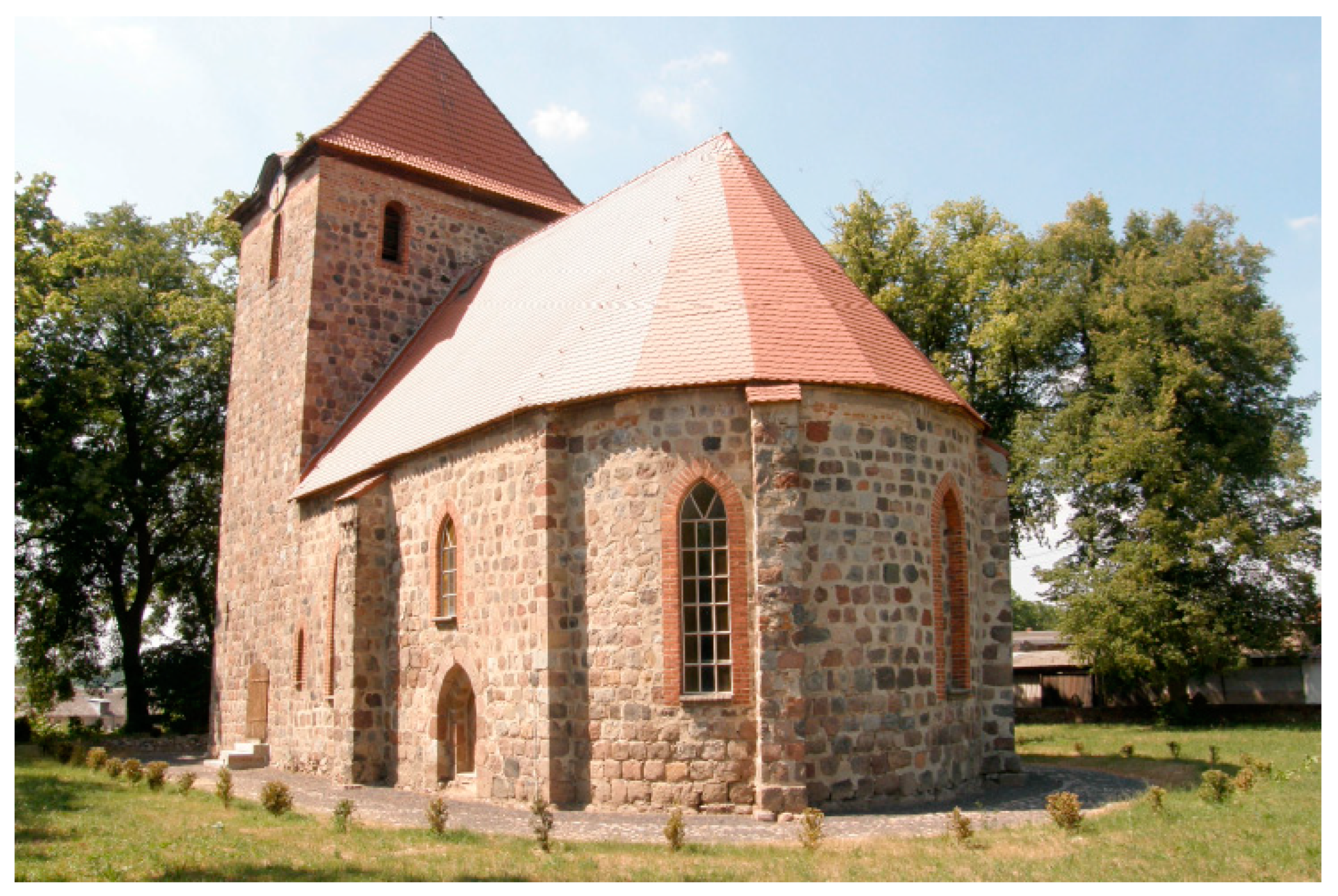
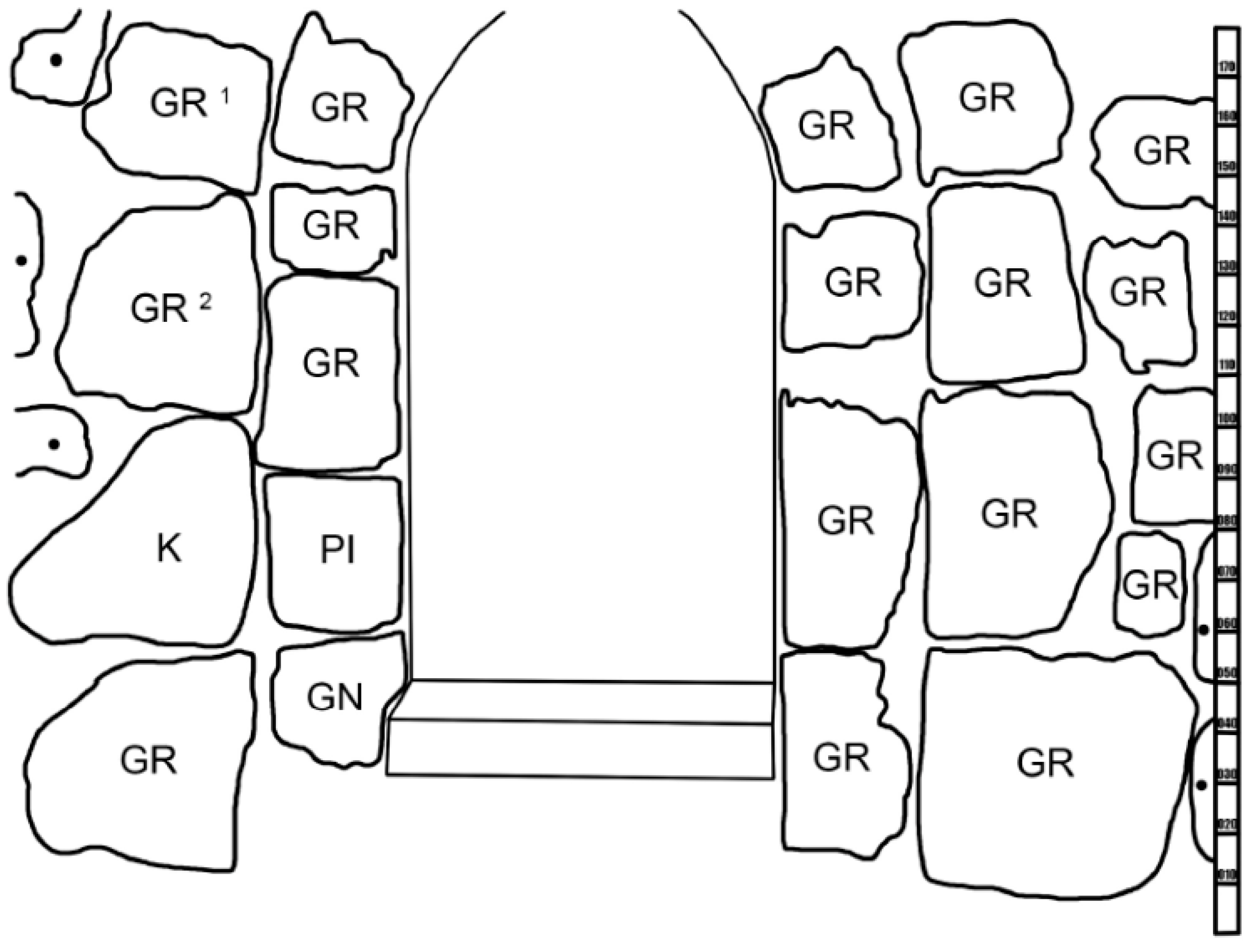
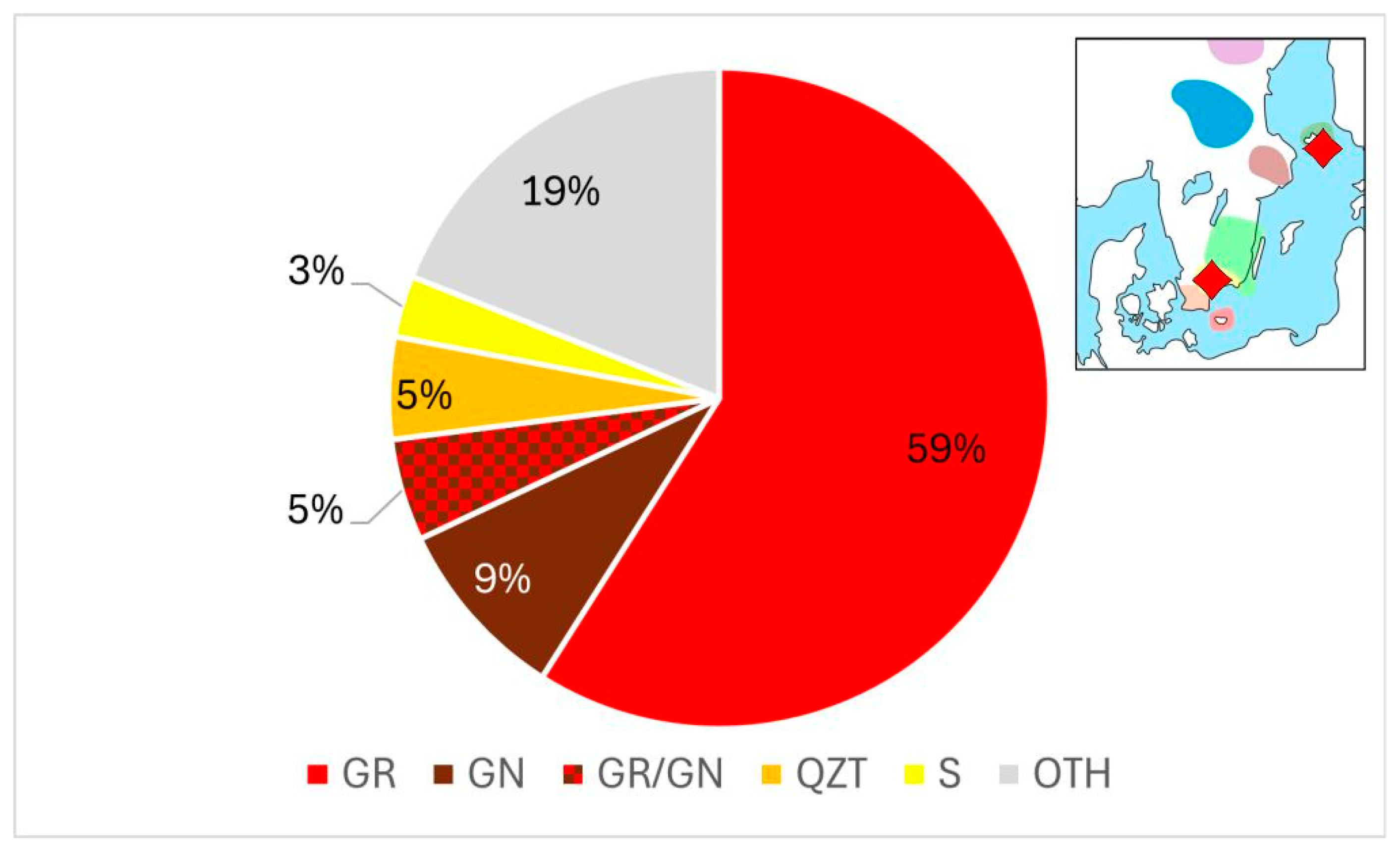

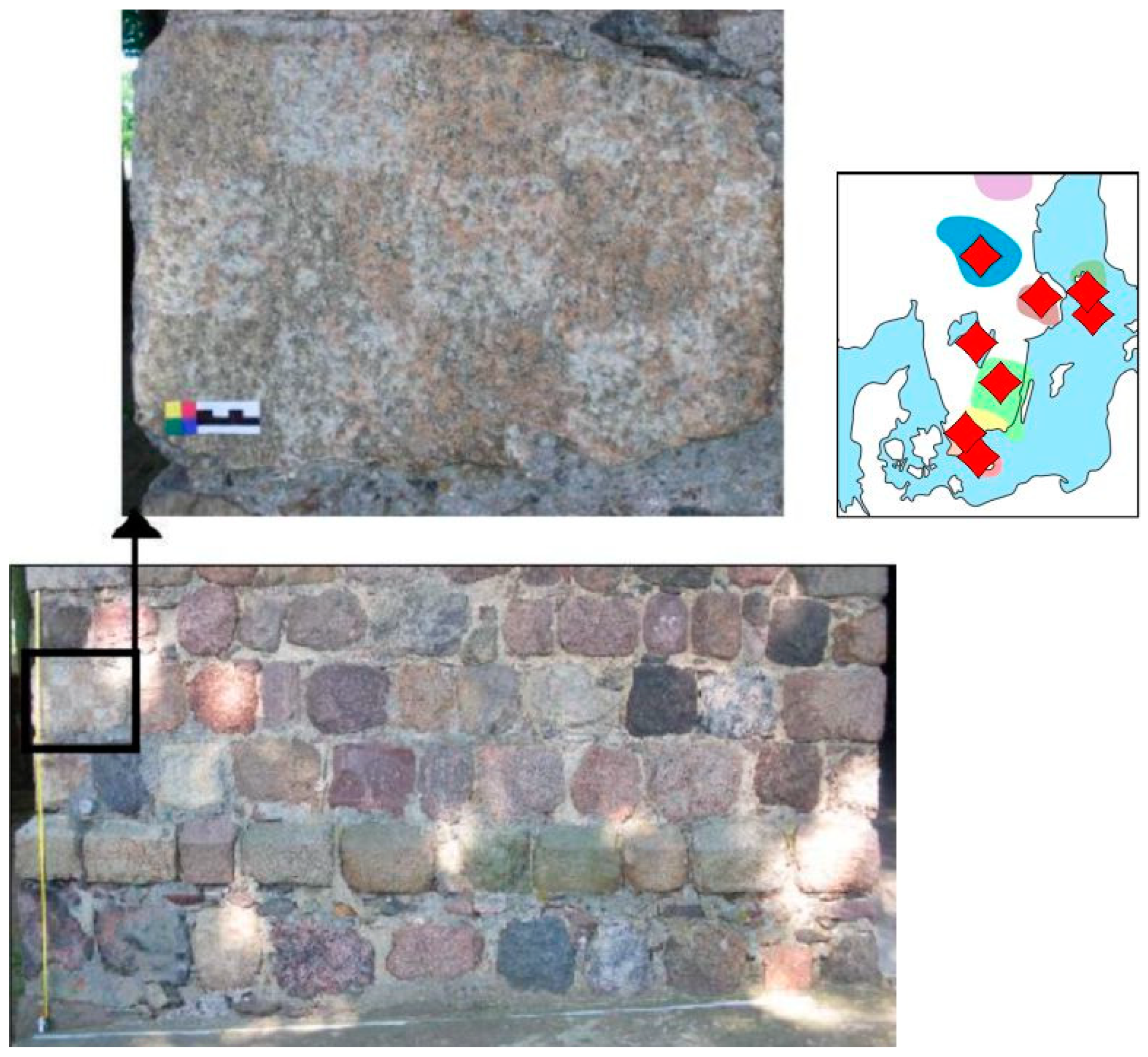
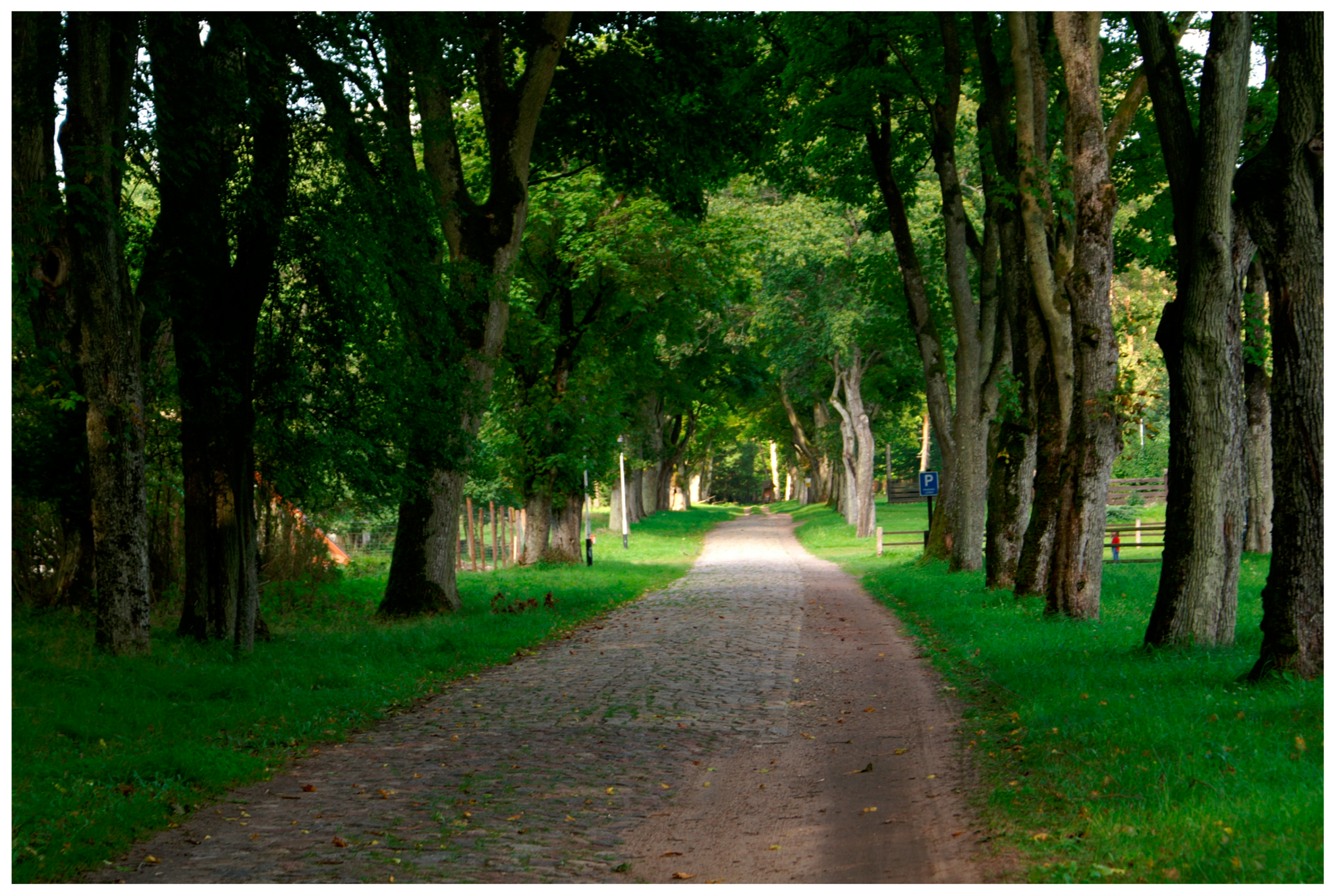
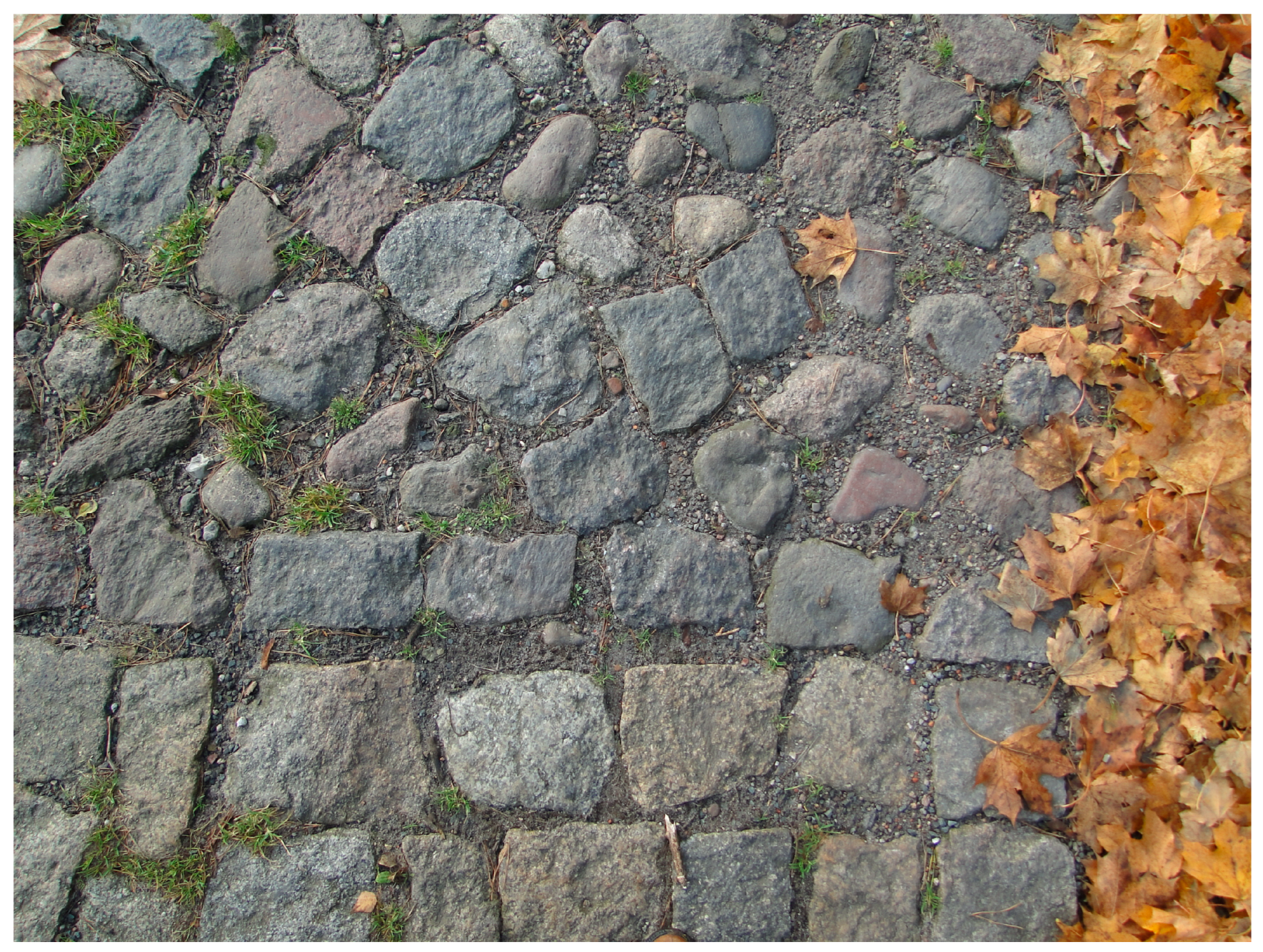


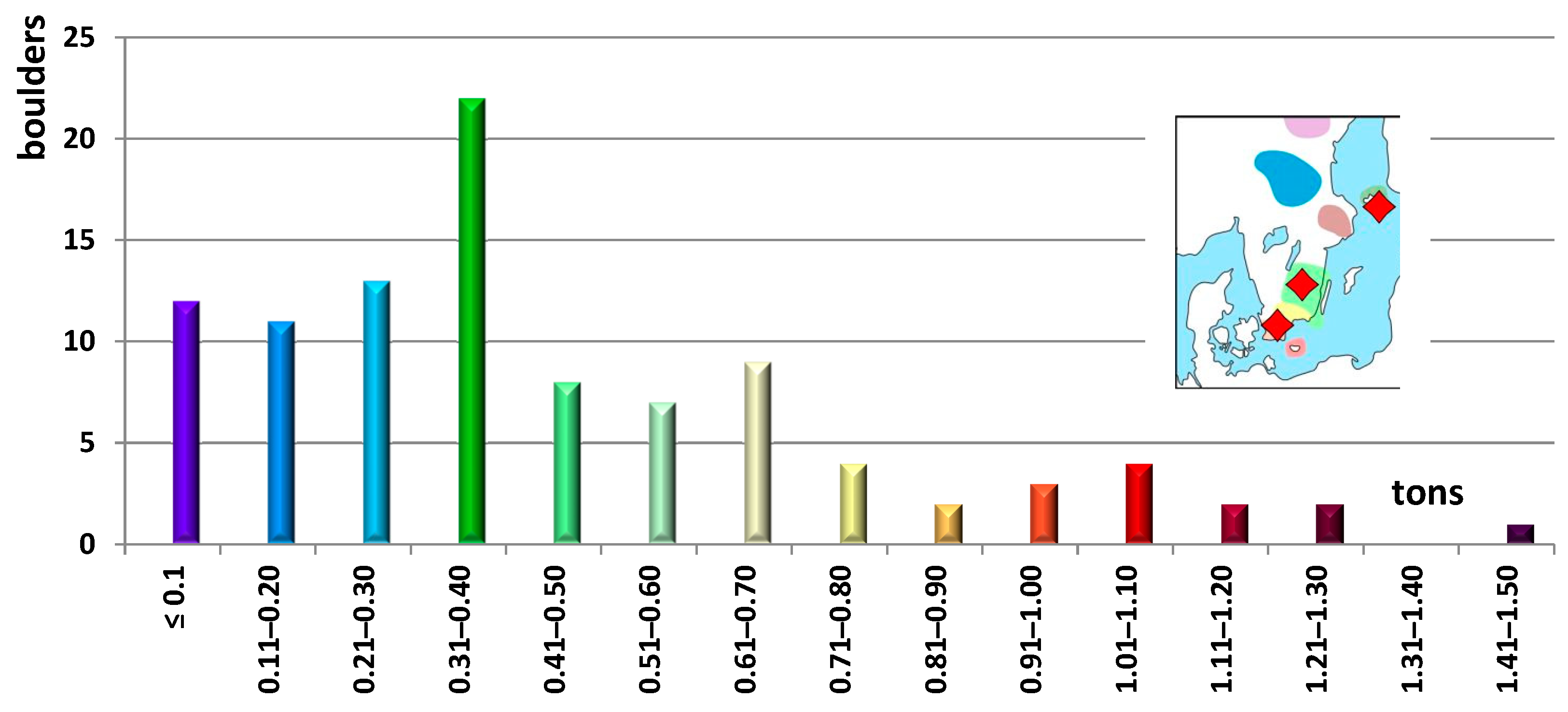

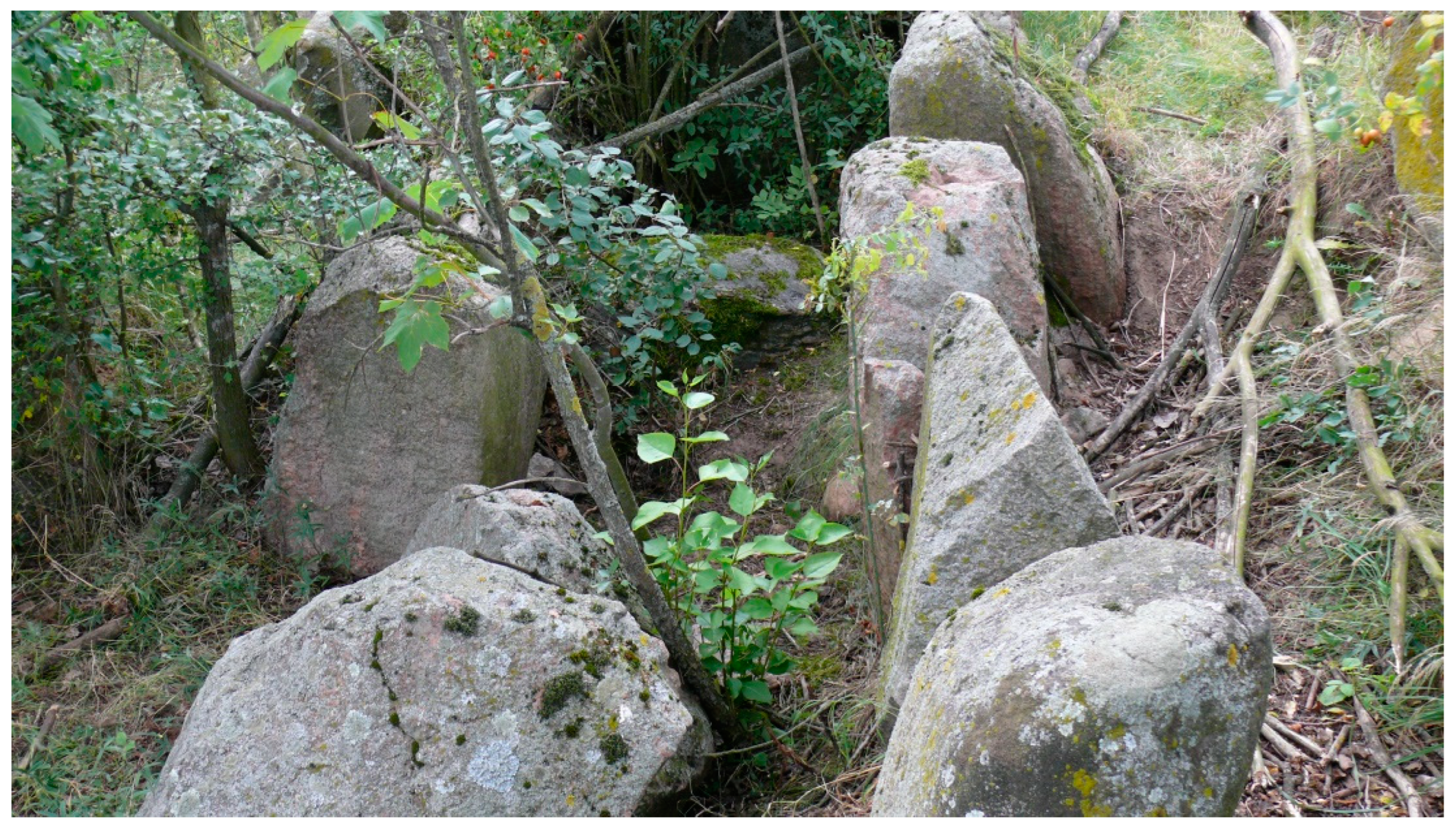
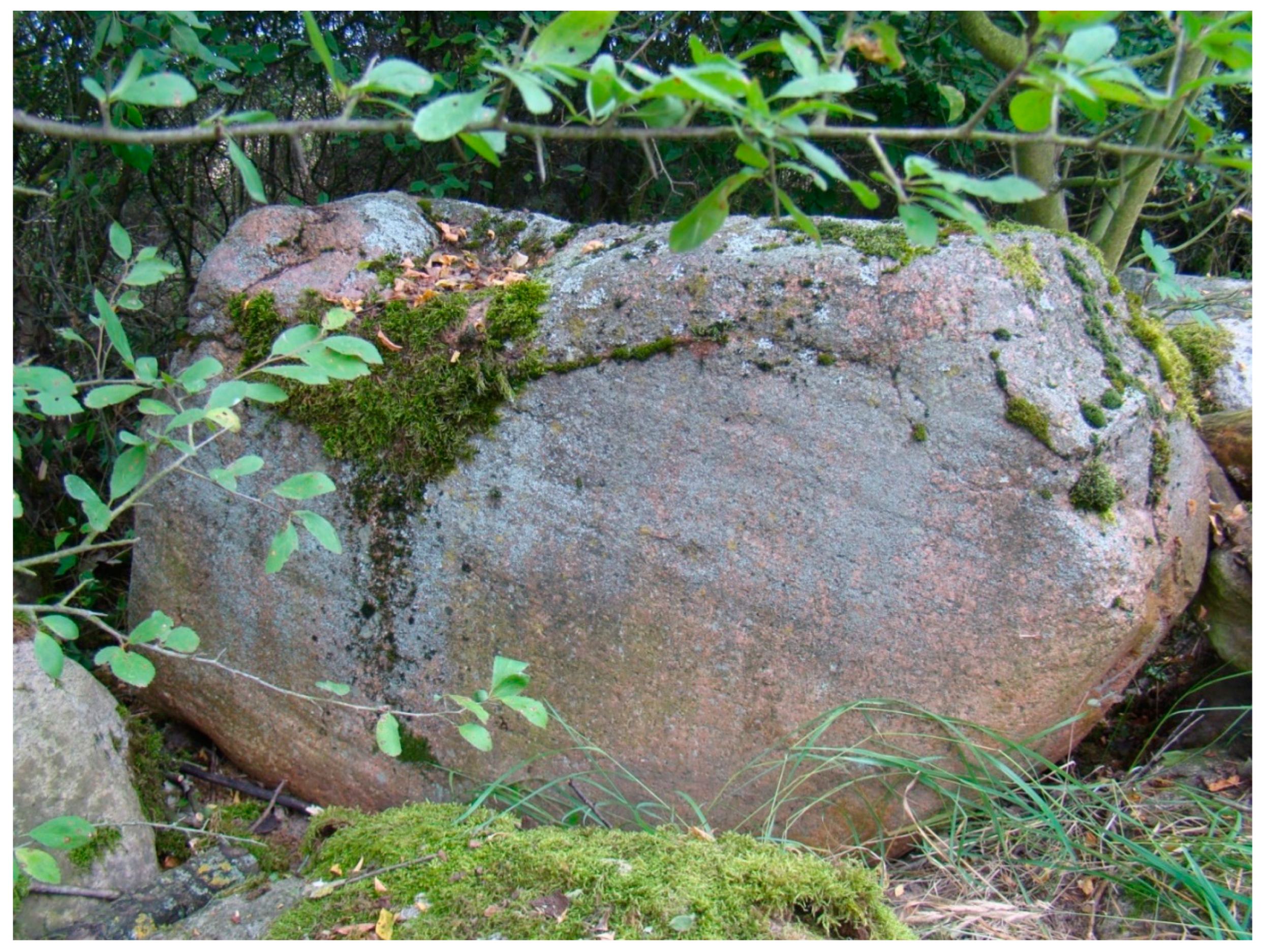


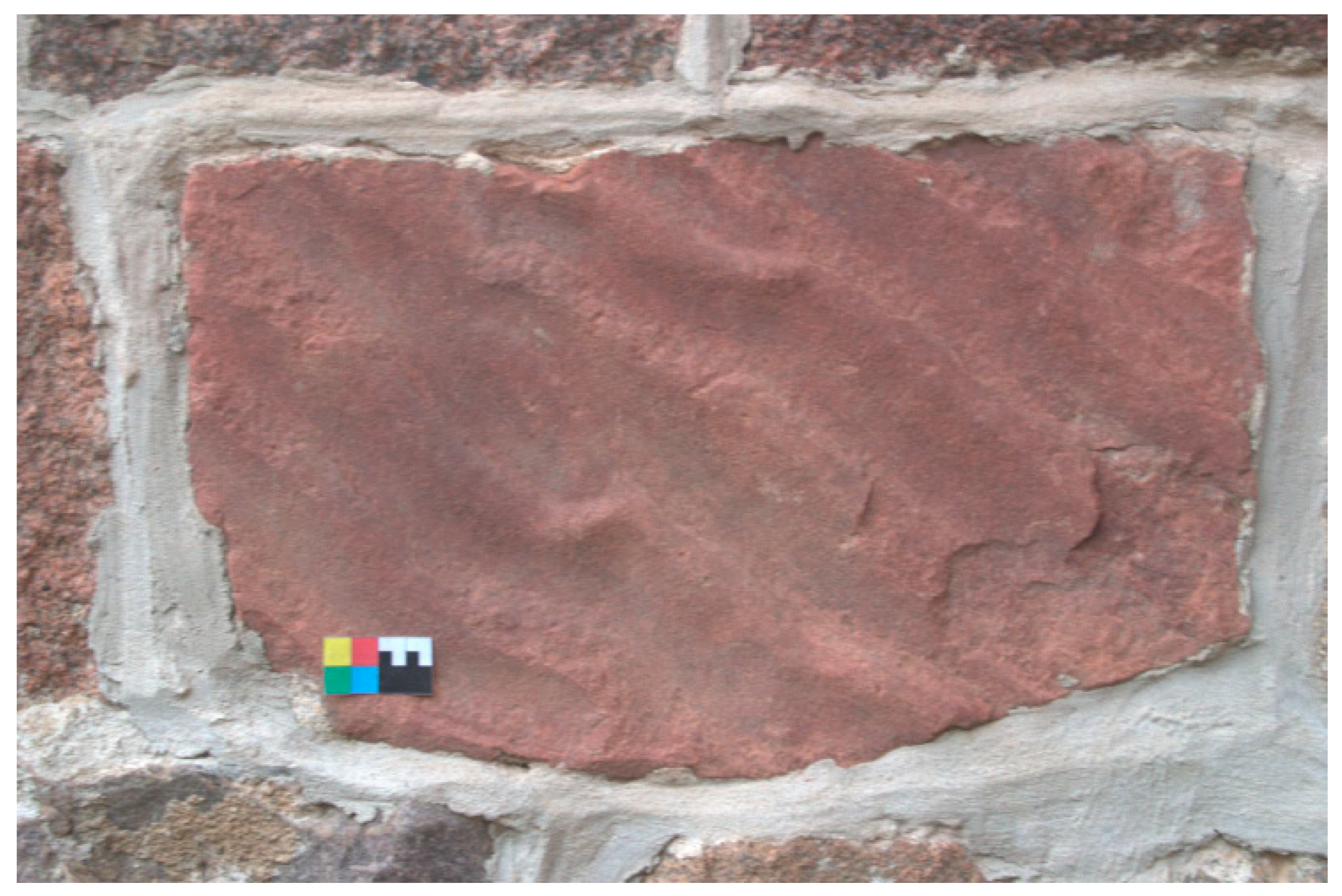
| Petrographic Type of an Erratic | Abbr. | No. of Pieces | Percentage Share |  |
| Gneiss | Gn | 19 | 8.1 | |
| Granite | G | 170 | 72.7 | |
| Granite-gneiss | Gr-Gn | 9 | 3.8 | |
| Quartzite | K | 3 | 1.3 | |
| Sandstone | P | 28 | 12.0 | |
| Porphyry | Po | 5 | 2.1 | |
| Sum | 234 | 100 | ||
Disclaimer/Publisher’s Note: The statements, opinions and data contained in all publications are solely those of the individual author(s) and contributor(s) and not of MDPI and/or the editor(s). MDPI and/or the editor(s) disclaim responsibility for any injury to people or property resulting from any ideas, methods, instructions or products referred to in the content. |
© 2024 by the author. Licensee MDPI, Basel, Switzerland. This article is an open access article distributed under the terms and conditions of the Creative Commons Attribution (CC BY) license (https://creativecommons.org/licenses/by/4.0/).
Share and Cite
Górska-Zabielska, M. Scandinavian Erratics in the Cultural Heritage Sites of Western Poland. Land 2024, 13, 1282. https://doi.org/10.3390/land13081282
Górska-Zabielska M. Scandinavian Erratics in the Cultural Heritage Sites of Western Poland. Land. 2024; 13(8):1282. https://doi.org/10.3390/land13081282
Chicago/Turabian StyleGórska-Zabielska, Maria. 2024. "Scandinavian Erratics in the Cultural Heritage Sites of Western Poland" Land 13, no. 8: 1282. https://doi.org/10.3390/land13081282
APA StyleGórska-Zabielska, M. (2024). Scandinavian Erratics in the Cultural Heritage Sites of Western Poland. Land, 13(8), 1282. https://doi.org/10.3390/land13081282






